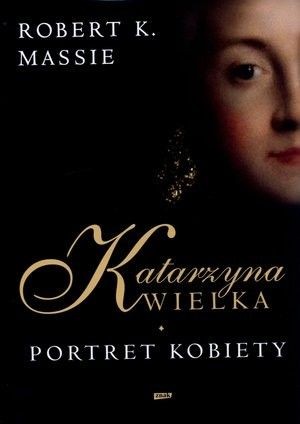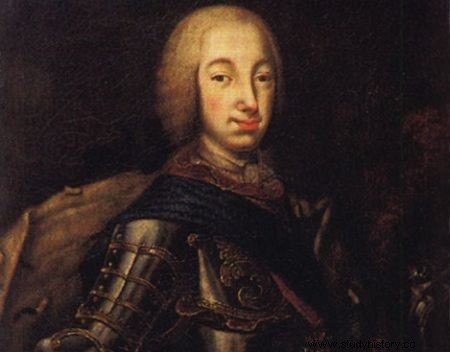Nobody expected that she would become a queen from little Sophia Frederick Augusta zu Anhalt-Zerbst-Dornburg. She herself did not aim that high either - she wanted, above all, to break free from the tutelage of her despotic mother. The fact that she became a Russian tsarina and one of the most powerful women in history was the result of a series of coincidences and ... the extraordinary determination of her mother, who for her part did everything to get rid of the branches.
I wrote about Zofia's childhood two weeks ago. Time to say something about the beginning of her great career. You probably remember that as soon as the girl began to grow up, her mother - Joanna von Holstein-Gottorp - made vigorous efforts to marry her. It is best to publish it so that Joanna herself gains prestige and makes new, valuable contacts.
The first ray of hope flashed in 1739. It was then that Joan's brother, Adolf Fryderyk, prince-bishop of Lübeck, became the protector of the orphaned 11-year-old prince of Holstein - Karol Piotr Ulryk.

Joanna von Holstein-Gottorp. She did not expect a marriage to emerge from the correspondence with the Tsarina…
As Robert K. Massie explains in the book “Katarzyna Wielka. Portrait of a Woman ”, he was a boy with great connections and no less great prospects. He was the only living grandson of Tsar Peter the Great of Russia and the first candidate to the throne of Sweden (p. 27) . At the same time, he was also a cousin of Zofia, who was a year younger. Joanna used this as an excuse to organize a meeting of the two children as soon as possible.
Zofia remembered Piotr quite positively. Years later she wrote that he seemed nice and well-mannered, although his taste for alcohol was noticeable (p. 27). She was culturally silent about a few less flattering facts.
The little prince had bulging eyes, he suffered from underdevelopment of the jaw, he was rather not very intelligent, he did not read anything, but he devoured himself without any restrictions .
Despite all these flaws, Zofia would be ready to marry him, just to run away from her mother. So far, however, there was no interest from the other side…
Cousin on the throne
Zofia got to know more potential candidates for a husband, quickly forgetting about meeting the strange Piotr. Meanwhile, in distant St. Petersburg, in the capital of a country that the girl didn't know anything about, there was a coup d'état.

In December 1741, Elizabeth, the younger daughter of Tsar Peter the Great, sat on the throne there. This woman, never expected to be a ruler, was closely associated with the von Holstein family, and thus with Joanna and her daughter Zofia.
First of all, years ago her eldest sister Anna married one of Joanna's cousins - Prince Charles Frederick of Holstein. It was from this relationship that the aforementioned Piotr Ulryk was born. The boy's mother died shortly after giving birth and the boy's father died a few years later.
There was also a much closer and deeply emotional relationship between Elizabeth and the von Holstein family. As Robert K. Massie writes, at the age of seventeen, the future tsarina was engaged to Joanna's older brother, Prince Charles August:
In 1726 he came to Saint Petersburg to get married, but a few weeks before the wedding the groom fell ill with smallpox in the Russian capital and died there. The grief for the lost love never completely left Elizabeth, who from then on considered the von Holstein family to be part of her own family (p. 29) .
Joanna was well aware of this last fact, and as soon as she found out about the coup in Russia, she sent congratulations to the tsarina who was once supposed to be her sister-in-law. Elizabeth - despite the sheer volume of duties - replied not only quickly, but also in a familiar, friendly tone. This gave rise to contacts that Joanna cultivated with great care.

Tsarina Elizabeth. She showered Joanna with diamonds, and finally decided to make her daughter an empress ...
Portraits and Diamonds
To deepen her friendship with the tsarina, she found an old portrait of her sister Anna among family mementos and offered to give it to her immediately. Elizabeth was delighted and immediately sent the secretary of the Russian embassy in Berlin to Szczecin. The clerk picked up the painting and in return handed Joanna ... a portrait of Elizabeth, framed in a diamond frame worth eighteen thousand rubles! Then Joanna:
Determined to maintain this promising connection, she took her daughter to Berlin, where the Prussian court painter (...) painted a portrait of Sophie as a gift for the empress. The portrait was average (…).
Nevertheless, when the effigy reached St. Petersburg, the longed-for answer came: "the Empress likes the expressive physiognomy of the young princess" (p. 30) .
There was no end to the Umizgom. Joanna had just become pregnant, and when she gave birth to her daughter, she quickly wrote to the tsarina informing her that she would name her baby Elizabeth and asking the ruler to graciously agree to become a godmother.
The Tsarina was captivated and ... soon another portrait of her appeared in Szczecin, also framed in diamonds (p. 31).
Peter the Russian gentleman…
So far, all these contacts brought Joanna only a prestigious benefit and a bit of profit (diamonds already worth tens of thousands of rubles!). It was only another event in distant Russia that decided the fate of little Zofia.
Elizabeth had no offspring and, figuring that she would no longer have one, brought the teenage prince of Holstein, Peter, to St. Petersburg. After completing the formalities (the boy had to relinquish the throne of Sweden) she made him her official successor.

Piotr Ulryk. He wasn't handsome. I am even more intelligent.
It was only necessary to find a suitable wife for him. The tsarina's gaze fell on the portrait of Sophia sent a few months ago and on the pile of letters from her "dear cousin" . After the next few weeks, Joanna received a sealed letter from the Grand Marshal of Piotr Ulryk's Court, Otto Brümmer.
The telegram contained an urgent invitation, sent by Elizabeth herself:to come to the Russian court, necessarily in the company of Sophia, and for a purpose that Joanna, being "sufficiently enlightened", would surely guess ...
Thus, the teenage Zofia went to Russia to soon take the name of Catherine, "convert" to Orthodoxy, marry an ignorant infantile and take the winding road to power.
Source:
- Robert K. Massie, Catherine the Great. Portrait of a woman , Społeczny Instytut Wydawniczy Znak 2012.
